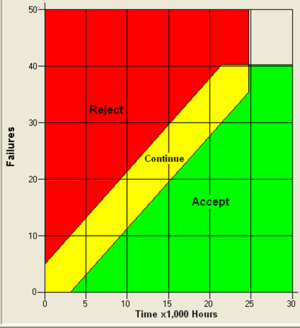| Reliability engineering |
Design for reliability
Design For Reliability (DFR), is an emerging discipline that refers to the
process of designing reliability into products.
This process encompasses several
tools and practices and describes the order of their deployment that an
organization needs to have in place in order to drive reliability into their
products. Typically, the first step in the DFR process is to set the system�s
reliability requirements. Reliability must be "designed in" to the system.
During system
design, the top-level reliability requirements are then allocated to
subsystems by design engineers and reliability engineers working together.
Reliability design begins with the development of a
model. Reliability models use block diagrams and fault trees
to provide a graphical means of evaluating the relationships between different
parts of the system. These models incorporate predictions based on parts-count
failure rates taken from historical data. While the predictions are often not
accurate in an absolute sense, they are valuable to assess relative differences
in design alternatives.
One of the most important design techniques is
redundancy. This means that if one part of the system fails, there is an
alternate success path, such as a backup system. An automobile brake light might
use two light bulbs. If one bulb fails, the brake light still operates using the
other bulb. Redundancy significantly increases system reliability, and is often
the only viable means of doing so. However, redundancy is difficult and
expensive, and is therefore limited to critical parts of the system. Another
design technique, physics of failure, relies on understanding the
physical processes of stress, strength and failure at a very detailed level.
Then the material or component can be re-designed to reduce the probability of
failure. Another common design technique is component
derating:
Selecting components whose tolerance significantly exceeds the expected stress,
as using a heavier gauge wire that exceeds the normal specification for the
expected
electrical current.
Many tasks, techniques and analyses are specific to particular industries and
applications. Commonly these include:
-
- Built-in test (BIT)
-
Failure mode and effects analysis (FMEA)
- Reliability simulation modeling
-
Thermal analysis
- Reliability Block Diagram analysis
-
Fault tree analysis
- Sneak circuit analysis
- Accelerated Testing
- Reliability Growth analysis
- Weibull analysis
- Electromagnetic analysis
-
Statistical interference
Results are presented during the system design reviews and logistics reviews.
Reliability is just one requirement among many system requirements. Engineering
trade studies are used to determine the
optimum balance between reliability and other requirements and constraints.
Reliability testing

A Reliability Sequential Test Plan
The purpose of reliability testing is to discover potential problems with the
design as early as possible and, ultimately, provide confidence that the system
meets its reliability requirements.
Reliability testing may be performed at several levels. Complex systems may
be tested at component, circuit board, unit, assembly, subsystem and system
levels. (The test level nomenclature varies among applications.) For example,
performing environmental stress screening tests at lower levels, such as piece
parts or small assemblies, catches problems before they cause failures at higher
levels. Testing proceeds during each level of integration through full-up system
testing, developmental testing, and operational testing, thereby reducing
program risk. System reliability is calculated at each test level. Reliability
growth techniques and failure reporting, analysis and corrective active systems
(FRACAS) are often employed to improve reliability as testing progresses. The
drawbacks to such extensive testing are time and expense.
Customers may choose to accept more
risk by eliminating
some or all lower levels of testing.
It is not always feasible to test all system requirements. Some systems are
prohibitively expensive to test; some
failure modes may take years to observe; some complex interactions result in
a huge number of possible test cases; and some tests require the use of limited
test ranges or other resources. In such cases, different approaches to testing
can be used, such as accelerated life testing,
design of experiments, and
simulations.
The desired level of statistical confidence also plays an important role in
reliability testing. Statistical confidence is increased by increasing either
the test time or the number of items tested. Reliability test plans are designed
to achieve the specified reliability at the specified
confidence level with the minimum number of test units and test time.
Different test plans result in different levels of risk to the producer and
consumer. The desired reliability, statistical confidence, and risk levels for
each side influence the ultimate test plan. Good test requirements ensure that
the customer and developer agree in advance on how reliability requirements will
be tested.
A key aspect of reliability testing is to define "failure".
Although this may seem obvious, there are many situations where it is not clear
whether a failure is really the fault of the system. Variations in test
conditions, operator differences,
weather, and
unexpected situations create differences between the customer and the system
developer. One strategy to address this issue is to use a scoring conference
process. A scoring conference includes representatives from the customer, the
developer, the test organization, the reliability organization, and sometimes
independent observers. The scoring conference process is defined in the
statement of work. Each test case is considered by the group and "scored" as a
success or failure. This scoring is the official result used by the reliability
engineer.
As part of the requirements phase, the reliability engineer develops a test
strategy with the customer. The test strategy makes trade-offs between the needs
of the reliability organization, which wants as much data as possible, and
constraints such as cost, schedule, and available resources. Test plans and
procedures are developed for each reliability test, and results are documented
in official reports.
|

